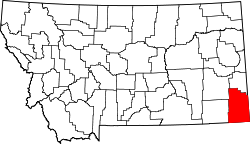Alzada, Montana Last updated October 05, 2025 History Alzada was first established in 1878, by 9th U.S. Infantry soldiers as Camp Devin , on the Deadwood, Dakota Territory to Fort Keogh , Montana Territory telegraph line. It was called the Little Missouri River Telegraph Station, and manned by soldiers of the 7th U.S. Cavalry . Then it was named Stoneville, after the local bartender Lou Stone. [ 4] It served as a stagecoach stop between Deadwood and Miles City, Montana . It was the site of a gun battle in 1884 between local authorities and rustlers known as the Axleby gang. [ 5] The town's name was changed from Stoneville in 1885, because of confusion with another similarly named community. The name "Alzada" came from an early settler named Laura Alzada Shelden. [ 6] Later settlers of the area were largely homesteaders.
In 1890, Private Peter Thompson , a 7th Cavalry survivor and recipient of the Medal of Honor for the Battle of the Little Bighorn , moved from Lead, Dakota Territory , with his brother William and homesteaded north of Alzada on the Little Missouri River at Nine Mile Creek.[ citation needed ]
Alzada was briefly in the news in September 1997, when a B-1 bomber crashed nearby.[ citation needed ]
Climate According to the Köppen Climate Classification system, Alzada has a semi-arid climate , abbreviated "BSk" on climate maps. [ 7]
There is a weather station located in the nearby community of Albion. [ 8] [ 9]
Climate data for Albion 1 N, Montana, 1991–2020 normals, 1945-2020 extremes: 3312ft (1009m) Month Jan Feb Mar Apr May Jun Jul Aug Sep Oct Nov Dec Year Record high °F (°C) 67 73 81 91 98 106 108 107 104 95 80 69 108 Mean maximum °F (°C) 50.4 54.1 67.9 77.2 86.0 92.0 99.4 98.0 94.7 81.4 67.2 52.4 99.9 Mean daily maximum °F (°C) 28.7 31.7 42.8 53.3 64.1 74.9 84.4 83.0 72.9 55.7 42.1 30.9 55.4 Daily mean °F (°C) 16.0 18.6 28.6 38.8 49.6 59.9 67.4 65.4 54.9 40.0 27.5 17.4 40.3 Mean daily minimum °F (°C) 3.3 5.6 14.4 24.2 35.2 44.8 50.4 47.7 37.0 24.4 13.0 3.8 25.3 Mean minimum °F (°C) −17.5 −13.6 −3.3 13.0 23.3 36.3 44.0 39.4 27.4 11.5 −4.4 −13.8 −25.7 Record low °F (°C) −39 −37 −36 −4 8 26 33 28 12 −15 −30 −38 −39 Average precipitation inches (mm) 0.27 0.48 1.03 1.62 3.14 3.03 1.90 1.95 1.09 1.32 0.31 0.42 16.56 Average snowfall inches (cm) 2.60 7.30 5.70 3.00 1.40 0.00 0.00 0.00 0.00 1.60 3.30 3.70 28.6 Source 1: NOAA [ 10] Source 2: XMACIS (temp records & monthly max/mins) [ 11]
Demographics Historical population Census Pop. Note %± 2020 25 —
References 1 2 3 4 U.S. Geological Survey Geographic Names Information System: Alzada, Montana ↑ "ArcGIS REST Services Directory" . United States Census Bureau. Retrieved September 5, 2022 . ↑ "Geographic Identifiers: 2010 Demographic Profile Data (G001): Alzada CDP, Montana" . U.S. Census Bureau, American Factfinder. Archived from the original on February 12, 2020. Retrieved October 8, 2014 . ↑ Carkeek Cheney, Roberta (1983). Names on the Face of Montana . Missoula, Montana: Mountain Press Publishing Company. p. 5. ISBN 0-87842-150-5 ↑ "Valentine's Day Shootout at Stoneville" . December 16, 2009. ↑ Aarstad, Rich, Ellie Arguimbau, Ellen Baumler, Charlene Porsild, and Brian Shovers. "Montana Place Names from Alzada to Zortman" Archived 2009-10-08 at the Wayback Machine ↑ Climate Summary for Alzada, Montana ↑ "Data of Meteorological Station Albion 1 N, Montana" . geographic.org. Retrieved December 28, 2023 . ↑ "Albion (in Carter County, MT) Populated Place Profile" . HomeTownLocator. Retrieved December 28, 2023 . ↑ "Albion 1 N, Montana 1991-2020 Monthly Normals" . Retrieved December 28, 2023 . ↑ "xmACIS" . National Oceanic and Atmospheric Administration. Retrieved December 28, 2023 . ↑ "Census of Population and Housing" . Census.gov. Retrieved June 4, 2016 . This page is based on this
Wikipedia article Text is available under the
CC BY-SA 4.0 license; additional terms may apply.
Images, videos and audio are available under their respective licenses.



